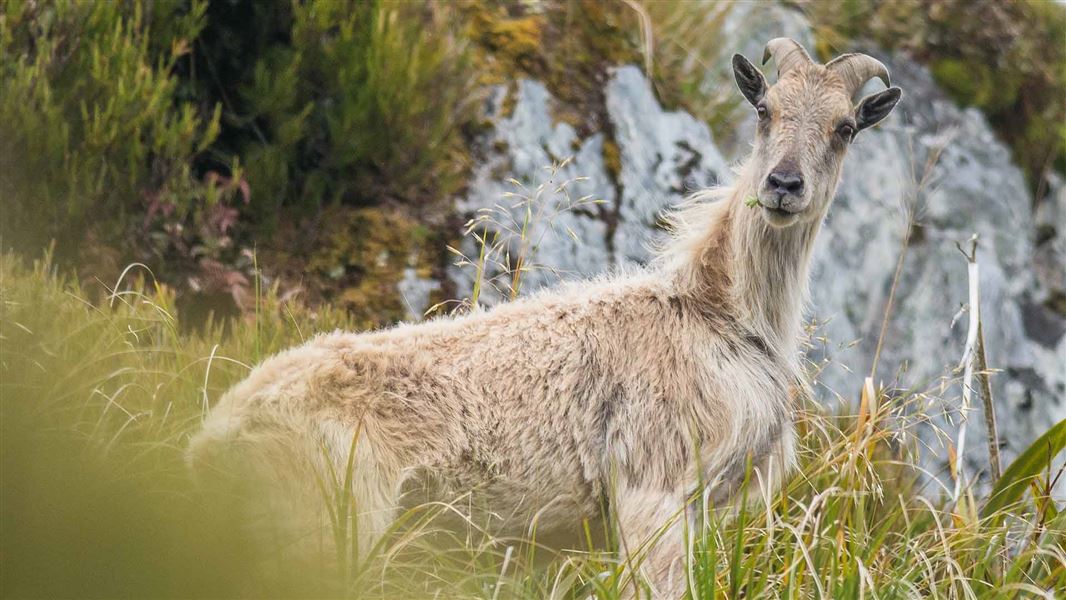Archived content: This media release was accurate on the date of publication.
Date: 25 February 2020
DOC estimates at peak there were more than 35,000 tahr on conservation land between the Haast Pass and Rakaia catchment, thriving on native plants with no natural predators to keep them in check.
DOC and hunters have controlled 12,000 tahr since last July, and DOC and Ngāi Tahu are leading the development of a long-term control plan to reduce the population to the limits of the Himalayan Thar Control Plan 1993.
DOC tahr programme manager, James Holborow, says native alpine and sub-alpine plants such as snow tussocks and some distinctive and iconic megaherbs will benefit from a reduced tahr population.
“New Zealand’s Kā Tiritiri o te Moana/Southern Alps are prized for their scenery, but we need to protect the environment and our native plants to keep it that way.
“Himalayan tahr eat a wide variety of plants, and while people have heard of some, such as the world’s largest buttercup - the Mount Cook buttercup, others like the scree buttercup, Ranunculus acraeus, are generally unknown but are as threatened as kea.
“Tahr are social animals and can move in large groups browsing alpine herbs, tussocks and shrubs. They have a patchy effect across the landscape, but large groups of animals can transform tall tussocks and subalpine shrublands to a grassy turf or bare ground,” says James Holborow.
DOC ecologist Ingrid Gruner says a monitored vegetation plot within the Zora Canyon on the West Coast is a sobering example of what can happen when tahr build up in an area.
“Photos of this plot over 13 years show the decline in vegetation quality as tall snow tussocks disappear and are replaced by shorter grasses and herbs.
“It’s heart-breaking to see the change over time. When we last visited the Zora Canyon, it more closely resembled a rough paddock than tall tussock grassland.
“Tahr are a relatively heavy animal and when they mob together they compact the ground. Their trampling creates tracking, opens up the vegetation and exposes soils, potentially leading to erosion. Their urine and faeces act as fertiliser changing the nutrient status of the soils. All this can have profound and long-lasting effects on the local ecosystem,” says Ingrid Gruner.
DOC has been working with ecological experts to design and implement a new monitoring system to assess the condition of native vegetation and better understand impacts across the tahr range. This should also provide information on the recovery of vegetation when tahr numbers are maintained at lower levels.
“Due to the very cold alpine environment, the recovery of native vegetation will be slow. We’re not sure how long it will take for native vegetation to bounce back or whether plant communities will ever be as healthy as they were before they were impacted by tahr,” says Ingrid Gruner.
DOC will soon meet with the Tahr Control Implementation Liaison Group to discuss ongoing tahr control to protect fragile alpine ecosystems.
“Hunters can help protect the environment and contribute to tahr management by hunting tahr and recording the number of tahr controlled using the new Tahr Returns App,” says James Holborow.
More about the Tahr Returns App.
Background information
Landcare Research and DOC have visited and monitored eight vegetation sites four times since 1993 to determine ecologically acceptable tahr densities. Monitoring sites focused on snow tussock grasslands.
Snow tussocks were chosen as the key indicator species as they make up a large part of tahr diet, but not of the diets of possum or chamois. The monitoring showed that tussocks had become shorter over time and that their height was related to tahr activity at the sites. This suggested that high tahr densities had led to a decline in the condition of tussock grasslands at these sites. The data were insufficient to determine what ecologically sustainable tahr densities might be.
DOC is now using a national monitoring framework to measure the health of ecosystems. This includes specific vegetation measures throughout the tahr feral range to build a better picture of tahr impacts.
DOC is working with Land Information New Zealand to get a better understanding of the number of tahr on Crown land. This will help both agencies develop a plan to target areas where tahr numbers are high.
More information about tahr feeding habits
Tahr feed in a range of alpine ecosystems including tussockland, herbfields, fellfields, screes and rocky terrain. They also feed in sub-alpine shrublands and higher altitude forests.
Tahr move around seasonally. In winter when snow cover restricts food supplies, they move to lower altitudes and feed more in shrubland and forest.
Tahr eat a range of herbaceous species including our distinctive megaherbs including the iconic Mt Cook buttercup, other large leaved buttercups; some alpine daisies; some native carrots including Haast’s carrot (Anisotome haastii), Anisotome pilifera and speargrass species; snow margarites and other species.
Some of the species that they feed on are highly palatable to a range of herbivores and have declined to the extent that they have a threat status. These include the species Ranunculus godleyanus, Ranunculus grahamii, Ranunculus buchananii, Ranunculus acraeus, Ranunculus haastii and Anisotome pilifera.
Contact
For media enquiries contact:
Email: media@doc.govt.nz
